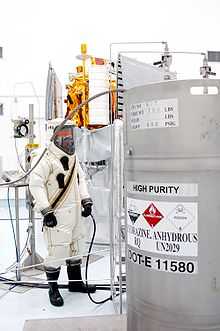
Back Hipergoliese dryfmiddel Afrikaans Hipergolik yanacaq Azerbaijani Hipergol Catalan Hypergolická reakce Czech Hypergolsk Danish Hypergolität German Υπεργολικό καύσιμο Greek Propergoles hipergólicos Spanish سوخت هایپرگل Persian Hypergolinen polttoaine Finnish

A hypergolic propellant is a rocket propellant combination used in a rocket engine, whose components spontaneously ignite when they come into contact with each other.
The two propellant components usually consist of a fuel and an oxidizer. The main advantages of hypergolic propellants are that they can be stored as liquids at room temperature and that engines which are powered by them are easy to ignite reliably and repeatedly. Common hypergolic propellants are difficult to handle due to their extreme toxicity or corrosiveness.
In contemporary usage, the terms "hypergol" and "hypergolic propellant" usually mean the most common such propellant combination: dinitrogen tetroxide plus hydrazine.[1]
- ^ Melof, Brian M.; Grubelich, Mark C. (2000-11-15). "Investigation of Hypergolic Fuels with Hydrogen Peroxide". 3rd International Hydrogen Peroxide Propulsion Conference. OSTI 767866.
© MMXXIII Rich X Search. We shall prevail. All rights reserved. Rich X Search